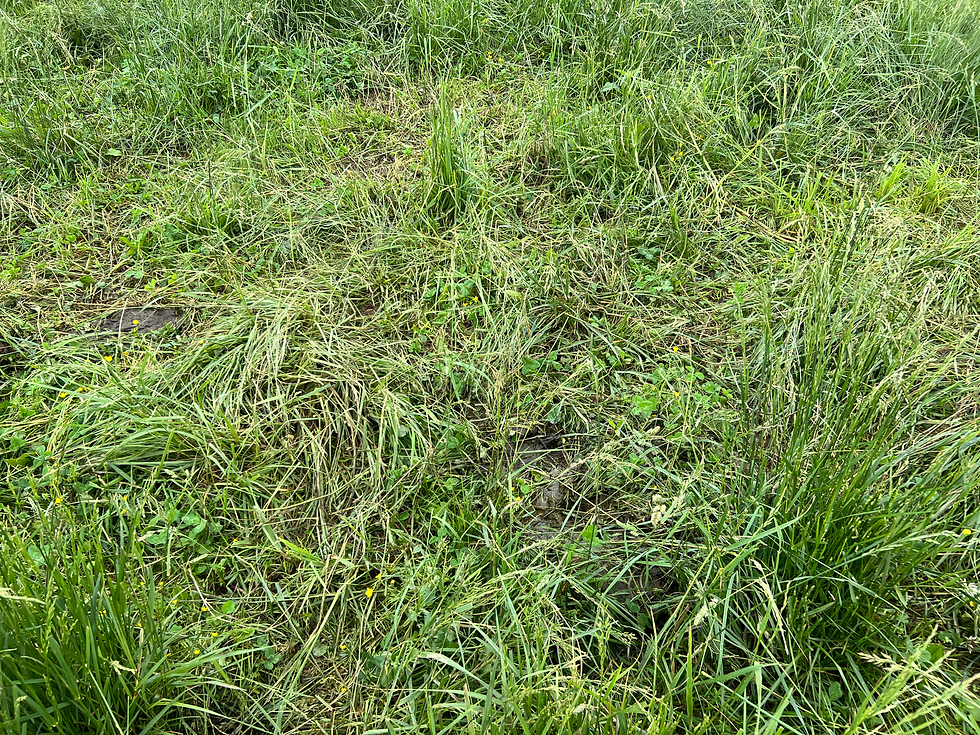Is All Pasture Created Equal?
- stecklerfamilymeat
- May 18, 2023
- 4 min read
Updated: Jul 24, 2023
As we move through spring and past pasture turnout, summer is approaching. One of our jobs on the farm throughout this season is moving cows to different sections of grass. This moving process is called rotational grazing. In more detail, rotational grazing is the dividing up of a larger pasture into smaller pastures. The cows then rotate from pasture to pasture leaving the ones previous to rest and regrow. Depending on the size of these pastures or the number of animals in one pasture, the cows can be moved every day, every few days, every week, or every few weeks. The amount of moving will all depend on how the farmer wants to manage the pasture. The resting of pastures (no grazing) is extremely important for the health and regrowth of grass. Below is an image that helps display rotational grazing from the USDA climate hub. This method of grazing is more labor intensive and will take additional fencing and water supplies to accomplish, but it pays back in the long run with healthier pastures.
When do we turn our cows to pasture? This timing is different for everyone, it may change based on the time of year. For us, we generally wait until the end of April or the beginning of May. This gives the pasture enough time to get quality growth and to mature. Often our grass has heads on it before we turn the cows out. We do this for several reasons. One is so that we ensure good growth for the entire growing season as it gives our applied fertilizer time to work. Second, the water content isn’t as high in the grass. We like this because of the change in diet the cattle go through from winter feed (which is dry) to spring grass (which is wet). If we let the grass mature a bit more before we turn out the cows then this diet change isn’t quite as drastic! A third reason we like to turn out at this time is that the grass is blooming and producing seed. This means that the grass is high in reproductive minerals because it is in its reproductive stage. These reproductive minerals are good for our cattle to consume and add additional support to their growing babies.

Figure 2: Cows grazing in part of our pasture. We just put them in this section of grass in this picture.

Figure 3: The pollen production is in full swing on this orchard grass head. This grass is in its reproductive state when producing pollen.

Figure 4: This is a picture of ryegrass headed out in the pasture.
When the cows are going through their first graze of the year we move them through the sections of pastures quicker because we want them to “top” off all the heads of the grass and not eat them to the ground. When we leave the pasture it still looks like there is a lot of grass remaining, and there is! This is intentional and allows the grass to continue to grow without getting too mature so that the cows won’t eat it. Once we move them through all the paddocks (smaller pastures) then we start over again with the second graze.

Figure 5: A bunch of grass that has been grazed down by the cows. The heads of the grass seen previously in figure 3 and 4 are eaten off and the grass can continue to grow.

Figure 6: A whole section of grass grazed down by the cows.
Grass in a pasture isn't just grass. There are different varieties that make it diversified. Some of those varieties include fescue, ryegrass, orchard grass, timothy, and legumes such as clover.




Figure 7-10: These pictures indicate individual grass and legume species that can be found in our pasture.
Having different types of forages within the pasture has great advantages including:
Diversity above the ground makes for a more diverse and active soil. There is a diverse array of roots from each species that will impact the soil profile. Different organisms in the soil thrive better from different forage species. Legumes will add nitrogen to the soil. This nitrogen can then be used by all the other grasses in the mixture.
Different species provide more palatability for the cattle. Cattle really like the taste of orchard grass, clover, and timothy, so we add those in to increase the taste of the pasture. However, these varieties are not as hardy to weather in this area, so we plant varieties such as fescue to ensure a good cover first and of growth.
The diversity of species also gives your pasture resilience. When the weather changes from year to year, the diverse species provide some insurance that you will have a good pasture to graze. As we said previously, different varieties are more hardy than others.
So really, all pasture is not created equal. Other blog posts will go into more detail about other types of grazing that can be done with your cows including cover crop and corn stalk grazing. On your next drive around the country side, check out all the pastures you see along the way!
Always,
Olivia, Tabby, Gina, & Kendra





Comments